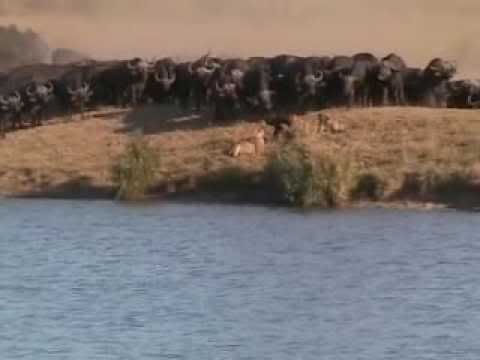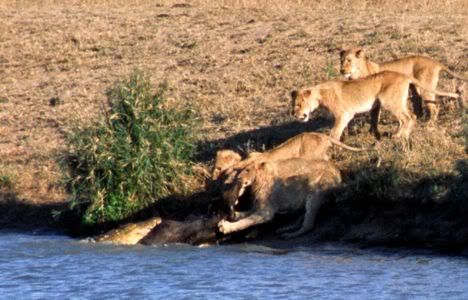The “Battle at Kruger” is said to be the creator of youtube.com’s favorite video, and has become an icon in the geographic world. It is a video of survival and a story of hope and justice. It is what takes me to my elevated state of consciousness. The Battle at Kruger is my sublime. In Longinus' On the Sublime, he says that "although nature is for the most part subject only to her own laws where matters of emotion and elevation are concerned, she is not given to acting at random and wholly without system. Nature is the first cause and the fundamental creative principle in all activities" (Murray 115).
In this almost eight and a half minute long video, every second of it will leave you breathless For eight minutes I guarantee you will be silent and still. Your heart will race and you will feel emotions that may have been deeply suppressed. This is the "Battle at Kruger":
If we start the video at 1:04, we can see the lions, crouched and waiting, pawing their claws on the ground, preparing their moment of attack. The video pans left and three buffalo are walking along the embankment. Two adults and one baby are walking literally into a lion’s den. As we are able to immediately point out is that all five lions are female, and in this type of feline pack, the lioness is the hunter. The buffalo approaching are not a game, they are food. They are lusting for the buffalo with the appetitive part of their being.
Nearly a minute the chase begins and quickly ends, one lion lands on the baby buffalo, rolling the both of them off the embankment and down to the edge of the water. All five females crowd the baby, teeth and dagger sharp claws embedded into the helpless baby. As the baby submerges deeper and deeper in the African river, another visitor comes in for the attack. A crocodile snatches the baby’s thigh and thus begins a tug of war between the lions and the crocodile. The five carnivorous cats prove stronger than the croc, and almost drag the croc out of the water with the baby. The buffalo is free from the water but not the jaws of the surrounding lioness. Almost immediately the herd moves in. Whether guided by instinct or rage, the herd tramples in closer and closer to the large cats. The buffalo move as one, and now have the advantage. They are much larger than the pack of lions, an therefore are given the upper hand. Plato’s theory was that justice was a worthwhile action. The herd had no idea if they would find the baby dead or alive, but they had the advantage and they took it.
The herd never stops. They inch closer and closer to the pinned down baby. Soon they begin prodding and swatting at the lions, bucking and kicking at them, chasing them away one by one.

The herd works as individuals and as one. They separate the lions, and push them as far down the embankment as possible. One buffalo even bucks one of the cats into the air sending her flying. Once the lions let go, the baby gets up on it’s own, and runs back into the safety of the herd.
According to Aristotle’s ideas of tragedy, this video fits in perfectly. The “Battle at Kruger” is ultimately performed as a tragedy. "In tragedy it is action that is imitated, and this action is brought about by agents who necessarily display certain distinctive qualities both of character and of thought, according to which we also define the nature of the actions; and it is on their actions that all men depend for success or failure. The representation of the action is the plot of the tragedy" (Murray 64). The video is serious, and tells a story that is performed rather than narrated, which are all elements that Aristotle points out to be part of a tragedy. The video arouses feelings of pity and fear. When the struggle of the baby locked in the jaws of the crocodile and the lions takes place, I fear for the baby buffalo and I endure pity on it.

Like humans, animals endure pain and suffering, and for the buffalo being so young, it resonates with the viewer. This is a story about an epic hero that takes back what rightfully belonged to his herd. In the beginning of the video, the baby and two adult buffalo are walking ahead of the rest, unaware of the crouching lions before them. This is where the hero, the adult buffalo, makes it’s fatal mistake. The baby is left open and unguarded. The tragedy continues, and the hero brings the herd in together and takes the lions head on.
The “Battle at Kruger” transcends limits, and stirs emotions. It is a tragedy and an epic poem in one. It is my sublime, and hopefully will now be yours too.
For more information on this video check out the link below
http://www.battleatkruger.com.
Battle at Kruger [video]. (2007) Retrieved January 30, 2009, from http://www.youtube.com/watch?v=LU8DDYz68kM
Murray, Penelope. Classical Literary Criticism. Penguin Books: New York, 2004